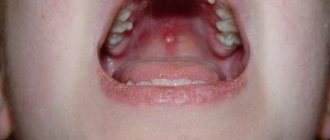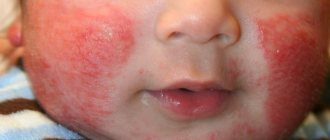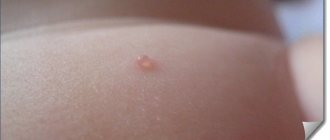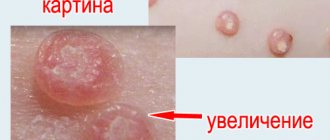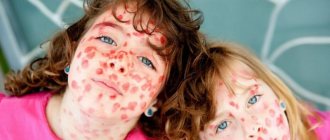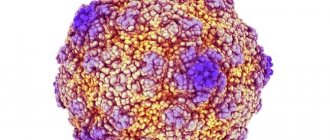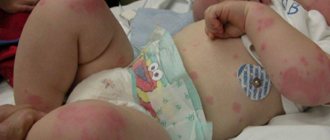Symptoms and treatment of prickly heat in children and adults + photos. Miliaria is an irritation and inflammation of the skin caused by high humidity and contact with irritants.
The cause of this disease is a violation of the evaporation of sweat and the separation of sebum.
If prickly heat is not treated, it may be accompanied by a bacterial infection or an allergic reaction to substances contained on the surface of the skin.
Miliaria itself does not pose a significant threat.
- Causes of prickly heat
- Symptoms of prickly heat
- Types of prickly heat
- Treatment of heat rash
- Complications of prickly heat
- Miliaria in newborns and infants
- Prevention of prickly heat
Causes of prickly heat
The appearance of prickly heat is associated with inflammation of the skin as a result of hyperhidrosis. The mechanism of development of the pathological process is as follows: under the influence of elevated body temperature, the protective functions of its cooling are activated - the pores open, sweat comes out, which leads to cooling of the body. When pores are clogged with sebum, cosmetics, or when the air is humid and hot, the process of sweating slows down and sweat begins to evaporate slowly, causing skin irritation.
Sweat contains salts and biologically active substances, which cause irritation. If you slow down the removal of excess sweat, the process of microbial reproduction will begin on the skin. Inflammation of the sweat glands, which develops as a result of the proliferation of pathogenic agents, forms miliaria; a small rash appears on the skin, accompanied by certain subjective symptoms.
The causes of the disease are divided into natural and pathogenic.
Natural causes include external factors not related to a person’s general health. Miliaria may appear as a result of:
- Wearing tight clothing made of synthetic material. The rash is localized on areas of the skin covered by clothing;
- Wearing tight shoes. Heat rash appears on the legs;
- Sports training or intense physical labor;
- Prolonged exposure of a person to a humid environment (dry hot climate) at high temperatures;
- Using low-quality cosmetics or cosmetics in large quantities. Cosmetics selected inappropriately for your skin type in large quantities can cause inflammation of the facial skin;
- Failure to comply with personal hygiene rules, in particular, prolonged exposure to sweat-soaked clothing, infrequent changes of shoes and socks for hyperhidrosis of the legs;
- Prolonged exposure to sunlight.
Pathogenic factors that provoke the appearance of prickly heat affect the functioning of the sebaceous glands, which leads to the appearance of the disease.
Common pathogenic causes include:
- Hyperhidrosis. It is a functional systematic disruption of the sebaceous glands, which results in increased sweating;
- Excess weight;
- Cardiovascular diseases and/or nervous disorders;
- Functional endocrine system disorders;
- Metabolic disorders;
- Fever as a result of a sharp increase in body temperature;
- Strokes, paralysis and other pathological conditions that lead to bedridden conditions. In addition to prickly heat, people who are unable to move may also develop bedsores.
What does prickly heat look like in adults, photo
Miliaria in adults can be of several types. There are three different subtypes of miliaria: papular, red and crystalline.
Visualization of rashes allows you to more clearly determine the specific type of pathology.
- Crystalline prickly heat in the photo has the form of frozen pearlescent drops, which consist of small (1 - 2 mm) painless, closely spaced vesicles. In some places it is possible to record their merging into large foci.
- The red form of miliaria has the form of red vesicles measuring 1–3 mm, which contain a cloudy liquid inside. In the photo you can see the resulting inflammatory, hyperemic crown around the papules.
- Papular miliaria is a type of miliaria rubra and develops from microbial eczema. In the photo you can see papules that are located in the dermis.
- Apocrine miliaria appears as a rash of small pink vesicles that may rupture.
Miliaria in the groin in men and its symptoms
The appearance of prickly heat in the groin of men is not uncommon. Pathology can also occur in women. The cause of the development of prickly heat in the groin area may be hyperhidrosis, when increased sweating is recorded. The condition may indicate tuberculosis, VSD, heart muscle disease.
Miliaria in the groin area can be provoked by:
- Climate change. Often prickly heat in men in the groin appears when traveling to warm countries where the climate is characterized by high levels of humidity and high temperatures. Usually, symptoms of diaper rash do not require treatment and go away on their own after acclimatization;
- Excess weight. Fat deposits lead to the formation of folds and friction of the inner thighs against each other, which leads to the appearance of prickly heat;
- Allergic reaction. Pathology may appear due to wearing tight clothing made of synthetic material. First, skin irritation appears, then prickly heat develops;
- Violation of personal hygiene rules. Failure to comply with sanitation standards leads to the accumulation of large amounts of dead tissue and secretions, which are the optimal microflora for the reproduction and activity of pathogenic microorganisms.
Miliaria in the groin of a man manifests itself as a small rash containing exudate. Gradually the condition worsens, the following is observed:
- Hyperemia of the skin, swelling;
- Skin soreness and increased sensitivity;
- Formation of wounds.
Miliaria in adults under the arms
Very often, prickly heat in adults appears in the armpit area, in areas of contact with clothing. The cause may be health problems and external factors. To prevent the occurrence of a pathological condition, you should change clothes frequently. Especially in the summer, do not leave a wet shirt on with wet armpits, take care of hygiene, take a shower often using special products for the care of sensitive skin.
Specially formulated antiperspirants and deodorants help prevent the appearance of prickly heat under the arms. To reduce sweating, it is also recommended to use unscented baby powders, as well as baby creams with chamomile or calendula. These products eliminate irritation and moisturize the skin. It is also useful to use antiseptic solutions based on salicylic and boric acid.
Rubbing armpits affected by prickly heat with a weak solution of manganese or fucorcin is effective. If itching bothers you, use antihistamines - suprastin, citrine, tavegil.
Heat rash on the legs in adults
Heat rash on the legs appears as a rash or small blisters that form on the surfaces of the skin. Often prickly heat appears on the feet, toes, arms, stomach, and groin. In these areas, clothing fits most tightly to the body, creating a greenhouse effect.
The causes and symptoms of heat rash on the legs generally do not differ from the causes and symptoms of other manifestations of this disease. The peculiarity of prickly heat on the legs is their localization. Rashes appear on the toes, between them and on the feet. The rashes can be clear, red or flesh-colored.
Crystalline prickly heat on the legs appears as white or transparent blisters up to 1 mm in size. In the photo you can see small groups of rashes that are combined. They can burst and become inflamed, which can lead to suppuration.
Miliaria rubra on the legs is revealed by expressive rashes in the form of nodules and blisters up to 2 mm in size. They are red in color and filled with cloudy liquid. This type of heat rash on the legs is characterized by severe itching.
Imaging allows you to see an accurate picture of papular heat rash on the legs. The legs are common sites for this type of heat rash. The rashes are small flesh-colored papules (vesicles) with a diameter of 1-2 millimeters.
Diagnostic measures
To accurately determine the diagnosis, a thorough examination of the patient is carried out. If skin rashes are a symptom of prickly heat, then procedures are prescribed, including hygienic ones, that will eliminate irritation and relieve profuse sweating.
In the case of allergies, diagnostic measures require determining the type of allergen that caused the body's immune response. For this purpose, special tests and various skin tests are used. Often, clarification requires diagnosing allergies using laboratory blood tests.
Recently, when carrying out diagnostics, they are increasingly turning to the Voll method, which determines the frequency of electrical oscillations at electropuncture points. Using a computer, the degree of functional changes in the subject’s body is measured and, based on them, appropriate treatment is prescribed.
Miliaria erythematosus in adults, treatment
Miliaria erythematosus in adults is an inflammatory type of disease. The disease is revealed by blistering rashes about 2 mm in diameter, red in color, which are often accompanied by inflammation in the superficial layers of the skin and severe itching. There is cloudy content inside the bottle. Over time, the disease progresses, the blisters burst and wet crusts appear, which indicates the addition of a bacterial infection. Miliaria rubra affects the armpits, skin between the buttocks, abdomen, elbows and forearms.
Miliaria rubra often appears in the groin area in overweight women. The disease requires serious treatment and does not go away on its own.
In most cases, prickly heat turns into a chronic disease with signs of infection.
Complicated miliaria requires treatment with antibacterial therapy using drying and anti-inflammatory drugs and antihistamines. Oral antibiotics may be prescribed if the disease or complications persist for a long time.
- Necessary measures are to eliminate factors that provoke pathology, maintain personal hygiene, treat the skin with antiseptic agents, improve skin ventilation, and maintain optimal temperature conditions in the room where the patient lives.
- Treatment of prickly heat begins with the use of local antiseptics. Boric and salicylic acids (1% alcohol solutions), chlorophyllipt are effective.
- Anti-prickly heat creams are used as a drying agent. Prescribe zinc ointment, calamine cream or dehistine. The ointment should be applied to clean skin with washed hands to prevent infection from entering the body.
- Powders that absorb excess sweat are effective. Baby powders, baneocin, and talc are prescribed.
- The appearance of the rash leads to wetting and itching. Special ointments relieve itching and have an antiseptic effect. The prickly heat ointment should have a non-greasy base to allow the skin to breathe after application.
- Antiseptics help destroy pathogenic microorganisms and dry the skin. Popular antiseptics include salicylic acid (alcohol solution), boric acid and an aqueous solution of potassium permanganate. Antihistamines are used to relieve swelling, inflammation, and itching. Tavegil, suprastin, fenkarol, cetrin are used.
- Oral antibiotics are used to treat miliaria erythematosus if there is a secondary infection associated with skin inflammation. Ciprofloxacin, azithromycin, amoxicillin, doxycycline are prescribed.
- The course of treatment for prickly heat also includes herbal medicine. The basis of this method are herbs and medicinal plants that have an antiseptic, disinfectant and drying effect. For prickly heat, baths with the addition of a decoction of chamomile, string, celandine or St. John's wort are recommended. The decoction is prepared from 4 tbsp. l. raw materials, which is poured into 1 liter of boiling water. The composition is infused until it cools completely, filtered and added to bath water.
- To treat prickly heat, oak bark is often used, which contains tannins, thanks to which the bark has a disinfecting, restorative and drying effect.
- A course of physiotherapy is also carried out, which includes reflexology and acupuncture. These methods provide an impact on the accumulation points of nerve endings associated with the center for regulating sweating in the brain.
Types and signs
Miliaria in an adult can occur in three clinical forms: papular, red, crystalline. Depending on the manifestations and severity of damage to the skin, the following types of prickly heat are distinguished: crystalline, red, white, papular, or deep. In adults, the papular type of the disease is most often recorded. There are 4 types of prickly heat, each of which has its own symptoms: crystalline, red, apocrine and papular.
Based on the degree of skin damage, a distinction is made between localized, when rashes appear on individual parts of the body, and generalized, when rashes are spread throughout the body.
Signs of prickly heat include a small rash in areas that are more susceptible to increased sweating, or on the folds of the skin, itching, swelling, sometimes crusts form in areas of scratching, hyperhidrosis, accompanied by peeling, and weeping skin. The color of the bubbles or nodules varies from pearlescent to crimson. The patient becomes nervous, sleep and rest patterns are disrupted, and he can only fall asleep in a room where the air temperature is quite low. With severe types of prickly heat, an increase in temperature and loss of appetite may occur.
Crystal prickly heat
This type of disease is considered the mildest and most harmless. The rash is pearlescent, small in size (1 – 2mm). A rash appears as a result of the active work of the sweat glands, mainly on the legs and arms, and on the torso. There is no itching or irritation. Symptoms go away on their own within 3 to 5 days, after which flaky skin remains.
Miliaria rubra
The skin rash has the form of blisters filled with liquid. Rashes with a diameter of about 2 mm are surrounded by inflammation. The liquid inside the blisters is cloudy, sometimes white, which indicates the severity and severity of the condition. The itching is very strong, which leads to scratching. As the disease progresses, weeping wounds form at the sites of the blisters, which become covered with a crust that tends to become soggy. The disease requires treatment; lack of therapy can aggravate the condition by adding secondary bacterial infections. Miliaria rubra appears mainly in the groin and armpits, in the area of skin under the mammary glands and on skin folds. The duration of treatment for this type is on average 10 days.
Miliaria alba
Miliaria alba is of the papular type. With miliaria alba, flesh-colored rashes appear, no more than 3 mm in size. Residents of tropical weather zones, who are unaccustomed to such a climate, are especially susceptible to this species. The disease is easily treatable; lack of treatment leads to progression to pyoderma.
Miliaria profuse
Represents a more severe course of the disease. This species is considered the next stage after miliaria rubra. Papular or deep miliaria occurs with a sharp change in climate, is characterized by an acute inflammatory process in the superficial layers of the skin and is accompanied by the development of papular vesicles (vesicles - papules). This type of prickly heat is detected by an increase in body temperature to subfebrile levels, pain in the affected areas of the skin, as well as swelling of problem areas and hyperemia.
Apocrine miliaria
The cause of this heat rash is a disruption of the apocrine glands located in the armpit, labia majora, nipple areola and around the anus. At the beginning of the disease, a small pink rash appears, after which infiltrates and painful pustules develop. The disease requires timely treatment.
Intertrigo
The human skin contains a large number of microbes, bacteria and fungi. If a person's immune system is functioning normally, these pathogenic agents are not a threat and cannot cause disease. With overheating, prolonged wetness, skin friction, increased sebum production, insufficient ventilation of the dermis, an allergic reaction, sweating or poor hygiene, the protective layer is destroyed. The skin becomes vulnerable to pathogens, which in a humid and warm environment begin to actively multiply, which causes irritation - diaper rash.
In adults, diaper rash can occur due to incorrectly chosen synthetic underwear, which rubs the skin and impairs its ventilation. Diaper rash often appears in obese people as a result of increased sebum production, when skin ventilation is impaired, sweating and irritation are observed.
People who are seriously ill, especially those with fever, kidney problems, endocrine diseases, or people with limited mobility are at risk of developing diaper rash. In this case, skin irritation can occur not only in the area of skin folds, but also on the back or shoulders. Diaper rash most often appears in the inguinal-femoral folds, on the buttocks, between the fingers, under the mammary glands, in the armpits, in the abdominal folds and cervical folds in overweight people.
Signs of diaper rash are:
- Redness of the skin (erythema) at the site of inflammation;
- Attachment of pimples (papules) to erythema;
- The appearance of wet areas (dry) with elevated local temperatures;
- Burning, itching and pain in the affected areas of the skin;
- The appearance of pain and burning when in contact with feces, if diaper rash forms in the groin.
Diaper rash develops in stages. In the initial phase, the skin becomes red in the area of inflammation. The second stage is characterized by bright erythema, the presence of cracks and erosions. The third stage is the most severe, since a secondary infection joins the inflammatory process.
To prevent the appearance of diaper rash, personal hygiene is recommended; diaper rash at an early stage can be treated using air baths, irradiation with a Minin lamp, UV irradiation and EHF therapy.
Diaper rash of the first and second stages is treated with Guardian balm. The product contains oils, vitamins e and a. The balm has antiseptic, antipruritic, anti-inflammatory and antimicrobial effects, and also promotes the regeneration of affected skin and increases the barrier functions of the skin.
Infected heat rash
Inadequacy of the sweat glands, as well as the effect of their secretion on the skin (sweat contains various salts and some substances harmful to the body) cause the development of prickly heat. As a result, skin irritation and an inflammatory process develops, which reduces natural defenses and makes the inflamed area permeable to various pathogens. If personal hygiene rules are not observed and severe forms of the disease are not treated, there is a risk of the inflammatory process spreading, as well as the introduction of pathogenic microorganisms into the skin, which leads to the development of infected miliaria.
Infected miliaria manifests itself in several types of rashes:
- Red infected prickly heat. The rashes have the form of red, itchy blisters that do not merge with each other and are characterized by relative homogeneity. On palpation, the blisters are painful; the pain may intensify when being in a warm room with high humidity. The most common localization of the red rash is the neck, axillary and buttock folds.
- White infected miliaria. In most cases it occurs in children. The cause of the development of miliaria alba is the penetration of pyogenic microflora into the thickness of the epidermis.
As a result, the development of bubbles filled with cloudy gray or white liquid is recorded.
The main causative agent of the disease is staphylococcus, which, if not treated in a timely manner, can lead to secondary skin changes and the formation of scars and depigmentation in place of former miliaria alba.
- Crystalline infected miliaria. May act as the initial phase of miliaria alba. It looks like bubbles with a clear liquid (accumulation of droplets of sweat). The rashes can merge with each other to form large areas. It often goes away on its own after washing or drying the skin with talcum powder.
- Deep infected miliaria develops quite rarely. Infection occurs when scratching at the time of their formation. Has a tendency to transform into other forms. It is localized, in most cases, on the skin of the torso, thighs and shoulders.
Doctor Komarovsky's opinion
Evgeniy Komarovsky warns that a rash is not a cause, but a consequence, so first of all it is necessary to establish what caused it. Factors in the appearance of skin rashes can be diathesis, mechanical damage, various infections, allergies and even a reaction to blood clotting. First, you should try to determine whether the rash is dangerous or not, and then look for its culprit. If there are no signs of infectious diseases, the baby is cheerful and active, and of all the symptoms there is only a rash - the cause may be allergies, prickly heat or insect bites. Mommy will have to remember the previous day and try to figure out what could have caused the baby to get sick - buying new clothes, eating an orange, or being bitten by small insects.
Doctor Komarovsky warns! If the rash on the child’s skin has elements of hemorrhage, and the baby is vomiting, call an ambulance immediately!
The beloved doctor states that with the onset of heat, the appearance of prickly heat is not at all uncommon. A cluster of small pimples surrounded by reddened skin most often appears on the neck, gradually spreading to the face, back and chest, and behind the ears. Dr. Komarovsky advises diluting a teaspoon of soda in a glass of water and wiping the affected areas with a cotton ball soaked in the solution, lightly patting it several times a day. You can also use simple starch, using it instead of powder, but the main thing is to keep the baby undressed as often as possible in the heat. Let your baby take a break from diapers and tight clothes, and let his skin enjoy the touch of cool air.
READ ALSO: Androgens in women - excess hair growth (hirsutism), acne
How to distinguish from disease
Miliaria reveals a rash and itching. At the initial phase of the disease, the bubbles are small in the form of red multiple dots located close to each other. Miliaria can be distinguished from other infectious diseases based on the special color and size of the rash.
With infectious diseases, in most cases, fever, general weakness, headaches, sometimes abdominal pain, and irritation are recorded. With prickly heat, an increase in temperature is possible only at the last stage of the pathology, when a secondary infection is associated with the inflammatory process. Pain in miliaria manifests itself upon palpation of the damaged area of the skin.
With heat rash, the patient feels relief when he is in a ventilated room where the temperature is low. The crystalline type of prickly heat goes away within 3 days without intervention, on its own.
Diseases with which the symptoms of prickly heat can often be similar: measles, scarlet fever, chickenpox. With scarlet fever, the skin becomes dry and resembles sandpaper. Measles appears as a rash on the inner surface of the cheeks; with chickenpox, the rashes take the form of reddish bumps filled with liquid, which spread very quickly throughout the body.
Miliaria can be distinguished from an allergic reaction by the shape of the rash.
Externally, an allergic rash often resembles hives (large blisters), eczema or neurodermatitis. These phenomena are accompanied by severe itching, dryness, and chills. In rare cases, the rash causes pain. Miliaria is localized on the folds and folds of the skin, allergies are localized on the face. An allergy can appear on the skin within 2 hours after contact with the allergen; prickly heat is not so fleeting. Miliaria quickly disappears when the thermal regime is normalized without any treatment. An allergic rash does not go away until the cause of the rash is completely eliminated.
Only a doctor can make an accurate diagnosis, and therefore it is wrong to self-medicate or use different medications based on guesswork.
Miliaria or Allergy: Differences Between Allergies and Miliaria
Despite all the external similarities, a careful examination of the rashes that appear and identification of the reasons for their appearance reveals significant differences between these two conditions. Moreover, it is necessary to make this distinction, since to eliminate prickly heat, hygienic procedures will be sufficient, and allergies will require complex therapeutic methods. First of all, for such patients, antihistamines are prescribed, a therapeutic nutrition regimen is determined, and most importantly, measures are taken to eliminate contact with the allergen.
What to do if detected
Miliaria in most cases appears in people suffering from diseases of the cardiovascular, endocrine or nervous system. Such pathologies are often accompanied by excessive sweating. Treatment of prickly heat should begin with eliminating the factors that caused the disease. Only a dermatologist can identify the exact cause of the disease. Timely detection and elimination of the cause of prickly heat guarantees a quick recovery.
In hot weather, it is recommended to wear loose clothing made from natural materials and use talc where the skin is in constant contact with clothing. On hot days, it is advised not to use fatty creams and cosmetics that can clog pores. You can use water-based lotions. Skin affected by prickly heat should be wiped with an antiseptic; alcohol solutions of salicylic or boric acid and a weak aqueous solution of potassium permanganate are suitable for this purpose. Swelling and itching can be eliminated with antihistamines (suprastin, tavegil).
In complicated cases, you should immediately contact a dermatologist, who will make an accurate diagnosis based on the nature of the rash, severity and duration of manifestation. The specialist will prescribe appropriate treatment after laboratory tests and a number of other necessary studies.
Reviews
Dear readers, your opinion is very important to us - therefore, we will be glad to receive feedback on the treatment of prickly heat in the comments, this will also be useful to other users of the site.
Alyona:
I always thought that heat rash only happens to babies in diapers, but now I had to experience its symptoms myself. When a rash appeared on my neck, which was accompanied by terrible itching, I got scared and went to the dermatologist. I was afraid that something serious was happening, although I was ashamed to go to such a specialist. And I looked, they were sitting in line with small children, and they were getting jobs - they were going through a commission, I calmed down a little. The doctor immediately determined that it was because of the heat, and it’s true that while on vacation at the dacha, I worked a lot in the beds and in the greenhouse, I sweated a lot, but my body couldn’t cope. I started taking antihistamines, which the doctor prescribed, calcium gluconate, and he also recommended natural juices. I quickly got rid of the itching, and the rash went away in a week and a half, without even a trace left.
Maria:
As a child, my child suffered from heat rash, and I tried not to wrap him up or overheat him, but as soon as he sweated a little, stasis irritation appeared. Moreover, this lasted up to five years, then it outgrew, the skin became rougher and everything went away.
Ointments and creams for prickly heat in adults
To treat prickly heat, ointments and creams are used that help dry the skin, activate regeneration, relieve itching and inflammation.
Topical preparations with zinc are used to dry the skin and reduce inflammation. Calamine, sudocrem, desitin prickly heat cream, pharmaceutical mash, zinc ointment, zindol are effective. Products with dexpanthenol are effective - bepanthen, d-panthenol, pantoderm.
In complicated forms of prickly heat, when a secondary infection is associated with the inflammatory process, ointments and creams with antibiotics are used. Tetracycline, erythromycin, levomekol, and ichthyol ointments are effective. Fenistil is used to relieve itching.
If the medications used are ineffective, the doctor may decide to include topical hormonal medications in the course of therapy. Such drugs have a complex effect, have a number of side effects, and should be used for a short course with gradual withdrawal. The most commonly prescribed are Dermaveit and Afloderm.
How to treat with medications
In case of complicated prickly heat, medications of different effects are added to general methods of therapy:
- Antihistamines to eliminate swelling and itching: Fenistil gel, Suprastin tablets, Claritin, Cetrin.
- Products that dry out inflamed areas: zinc ointment, Sudocrem, Desitin, Calamine (lotion or cream) or regular pharmacy mash.
- Anti-inflammatory drugs with local action: tetracycline, endometrinic ointments, Levomekol.
- Products that accelerate tissue healing and soften dry skin: Bepanten, Panthenol, Pantoderm.
- Broad-spectrum antibiotics: Azithromycin, Doxycycline.
- Hormonal ointments: Afloderm, Dermaveit. Used in extreme cases when other means have not given the desired result. They cause some side effects, so use should be monitored by your doctor.
All products for external use are applied to clean skin in a thin layer.
To increase the protective properties of the skin, a course of vitamins A, E and C is prescribed.
Treatment at home
You can alleviate the condition and treat prickly heat at home at the initial stage of the disease. In complicated forms of the pathology, especially when a secondary infection is also detected, prickly heat should be treated only under the supervision of a doctor.
To eliminate heat rash, adjusting your diet is important. It is recommended to enrich the menu by introducing lentils, pomegranate juice and sorrel. These products have a positive effect on the functioning of the sweat glands and reduce the irritating effect of sweat on the skin.
It is recommended to use laundry soap that does not contain perfumes to wash your skin. This soap dries out the bubbles well and cleanses the skin of substances that cause dryness.
It is recommended to treat skin affected by prickly heat with a soda solution, since soda has an antiseptic and drying effect and promotes rapid recovery and reduction of inflammation. You can prepare a soda solution from one teaspoon of baking soda with the addition of a glass of boiling water.
Disposable wipes help alleviate the condition, stop the spread of the inflammatory process and prevent the penetration of secondary infections. A person suffering from heat rash should always have paper napkins on hand. These napkins are used to rub wet areas with freed serous content. It is applied to the rash, gently pressed and removed. Menthol wet wipes are a recommended option.
All procedures must be done with cleanly washed hands, since personal hygiene is especially important in the presence of rashes and damage to the skin.
When to see a doctor
Show increased attention to the baby's body. If you notice that the rash has begun to fester, peeling or cracks have appeared on the skin, the baby is restless, the rash is itchy or has a fever, do not delay your visit to the doctor. You should also visit your pediatrician if you have the following symptoms:
- the baby has swelling;
- blisters on the skin have an unpleasant odor;
- cracks appeared on the surface of the lesions;
- when touching the redness, the baby experiences discomfort or pain;
- skin itches or burns;
- body temperature increased.
Each of these symptoms should alert parents, because they may indicate the appearance of inflammation or infection. Timely contact with a specialist will help maintain the child’s health. The doctor will conduct a visual examination of the baby, interview the parents, and based on this data he will be able to establish the correct diagnosis. In some cases, you may need to get tested and visit a dermatologist.
Miliaria often causes itching, which may cause the child to scratch the affected areas, which increases the risk of infection.
Prevention
You can prevent the appearance of prickly heat if you follow certain rules and avoid excessive sweating.
Often prickly heat appears due to obesity, and therefore getting rid of extra pounds allows you to take the first step towards normalizing the functioning of the sweat glands and preventing the appearance of a pathological process on the skin.
Necessary:
- In hot weather, wear light clothing made of natural fabric, thus providing ventilation to the body. Clothes should not fit the body; they should be changed as often as possible;
- Avoid excessive physical exertion, especially in hot weather;
- Take water procedures twice a day, then wipe thoroughly;
- Limit your time in the sun, and do not use cosmetics and creams that clog pores during the summer season. It is advised not to overuse deodorizing products in order to prevent the appearance of a sweaty odor, since the use of some products in large quantities can cause irritation;
- Ensure regular ventilation of the premises, avoid high humidity and stuffiness.
Miliaria can be cured completely if therapy is organized in a timely manner. To prevent relapse, it is necessary to observe preventive measures and personal hygiene standards.
Choice of treatment method
Treatment of prickly heat consists of eliminating the factors that contributed to its development. It is necessary to create conditions that ensure sufficient breathing of the skin and keep it clean. For this purpose, it is necessary to carry out water hygiene procedures daily, ventilate the living space more often and wear clothes made from natural fabrics. Certain nutritional principles can also affect the skin; carrot and pomegranate juice, plums, sorrel, and lentils will help bring it into a healthy state. During the treatment period, you should avoid spicy and fatty foods. To get rid of crystalline prickly heat, this may be enough.
Treatment of miliaria rubra and papular miliaria will take longer; to eliminate their symptoms, the following prescriptions will be required:
- Taking antihistamines,
- Anti-inflammatory and drying medications,
- Antibacterial drugs.
Antibiotics are prescribed only in cases of long-term disease accompanied by complications.
Mild cases of prickly heat go away on their own when the provoking factors are eliminated and do not require drug therapy. Qualified medical care may be required only in the case of chronic hyperhidrosis.
